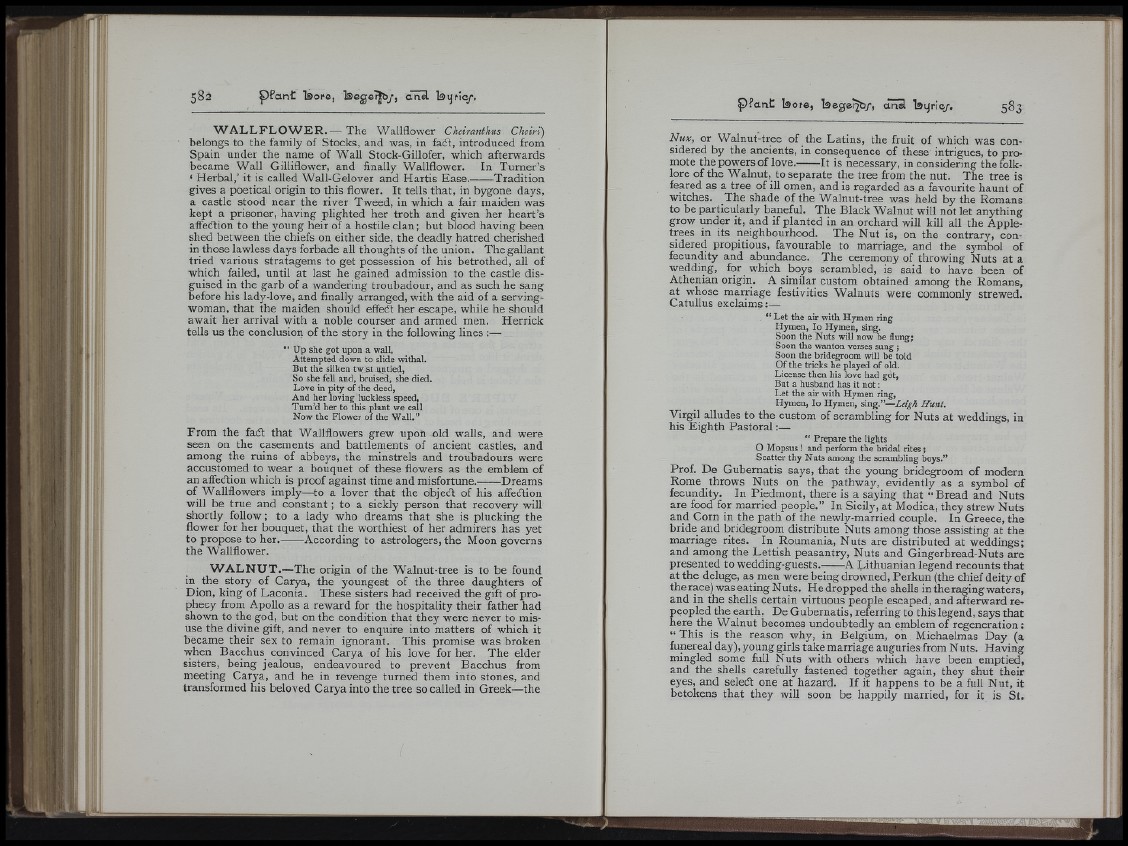
w l i
f
I - i: 5
It
SL
W A L L F L OW E R .— The Wallflower Cheiranthus Cheiri)
belongs to the family of Stocks, and was, in faCt, introduced from
Spain under the name of Wall Stock-Gillofer, which afterwards
became Wall Gilliflower, and finally Wallflower. In Turner’s
‘ Herbal,’ it is called Wall-Gelover and Hartis Ease. Tradition
gives a poetical origin to this flower. It tells that, in bygone days,
a castle stood near the river Tweed, in which a fair maiden was
kept a prisoner, having plighted her troth and given her heart’s
affection to the young heir of a hostile clan; but blood having been
shed between the chiefs on either side, the deadly hatred cherished
in those lawless days forbade all thoughts of the union. The gallant
tried various stratagems to get possession of his betrothed, all of
which failed, until at last he gained admission to the castle disguised
in the garb of a wandering troubadour, and as such he sang
before his lady-love, and finally arranged, with the aid of a serving-
woman, that the maiden should effeCt her escape, while he should
await her arrival with a noble courser and armed men. Herrick
tells us the conclusion of the story in the following lines :—
“ Up she got upon a wall,
Attempted down to slide withal.
But the silken twist Jintied,
So she fell and, bruised, she died.
Love in pity of the deed.
And her loving luckless speed,
Tiu-n’d her to this plant we call
Now the Flower of the Wall,”
From the faCt that Wallflowers grew upon old walls, and were
seen on the casements and battlements of ancient castles, and
among the ruins of abbeys, the minstrels and troubadours were
accustomed to wear a bouquet of these flowers as the emblem of
an affection which is proof against time and misfortune. Dreams
of Wallflowers imply—to a lover that the objeCt of his affeCtion
will be true and constant; to a sickly person that recovery will
shortly follow; to a lady who dreams that she is plucking the
flower for her bouquet, that the worthiest of her admirers has yet
to propose to her. According to astrologers, the Moon governs
the Wallflower.
W A L N U T .—The origin of the Walnut-tree is to be found
in the story of Carya, the youngest of the three daughters of
Dion, king of Laconia. These sisters had received the gift of prophecy
from Apollo as a reward for the hospitality their father had
shown to the god, but on the condition that they were never to misuse
the divine gift, and never to enquire into matters of which it
became their sex to remain ignorant. This promise was broken
when Bacchus convinced Carya of his love for her. The elder
sisters, being jealous, endeavoured to prevent Bacchus from
meeting Carya, and he in revenge turned them into stones, and
transformed his beloved Carya into the tree so called in Greek—the
Nux, or Walnut-tree of the Latins, the fruit of which was considered
by the ancients, in consequence of these intrigues, to promote
the powers of love. It is necessary, in considering the folklore
of the Walnut, to separate the tree from the nut. The tree is
feared as a tree of ill omen, and is regarded as a favourite haunt of
witches. The shade of the Walnut-tree was held by the Romans
to be particularly baneful. The Black Walnut will not let anything
grow under it, and if planted in an orchard will kill all the Apple-
trees in its neighbourhood. The Nut is, on the contrary, considered
propitious, favourable to marriage, and the symbol of
fecundity and abundance. The ceremony of throwing Nuts at a
wedding, for which boys scrambled, is said to have been of
Athenian origin. A similar custom obtained among the Romans,
at whose marriage festivities Walnuts were commonly strewed.
Catullus exclaims:—
“ Let the air with Hymen ring
Hymen, lo Hymen, sing.
Soon the Nuts will now be flung;
Soon the wanton verses sung;
Soon the bridegroom will be told
Of the tricks he played of old.
License then his love had got,
But a husband has it not:
Let the air with Hymen ring,
Hymen, lo Hymen, sing.”—Leigh Hunt.
Virgil alludes to the custom of scrambling for Nuts at weddings, in
his Eighth Pastoral:—
“ Prepare the lights
O Mopsus! and perform the bridal rites ;
Scatter thy Nuts among the scrambling fe y s .”
Prof. De Gubernatis says, that the young bridegroom of modern
Rome throws Nuts on the pathway, evidently as a symbol of
fecundity. In Piedmont, there is a saying that “ Bread and Nuts
are food for married people.” In Sicily, at Modica, they strew Nuts
and Corn in the path of the newly-married couple. In Greece, the
bride and bridegroom distribute Nuts among those assisting at the
marriage rites. In Roumania, Nuts are distributed at weddings;
and among the Lettish peasantry. Nuts and Gingerbread-Nuts are
presented to wedding-guests. A Lithuanian legend recounts that
at the deluge, as men were being drowned, Perkun (the chief deity of
the race) was eating Nuts. He dropped the shells in the raging waters,
and in the shells certain virtuous people escaped, and afterward repeopled
the earth. De Gubernatis, referring to this legend, says that
here the Walnut becomes undoubtedly an emblem of regeneration :
“ This is the reason why, in Belgium, on Michaelmas Day (a
funereal day),young girls take marriage auguries from Nuts. Having
mingled some full Nuts with others which have been emptied,
and the shells carefully fastened together again, they shut their
eyes, and seledl one at hazard. I f it happens to be a full Nut, it
betokens that they will soon be happily married, for it is St.
................